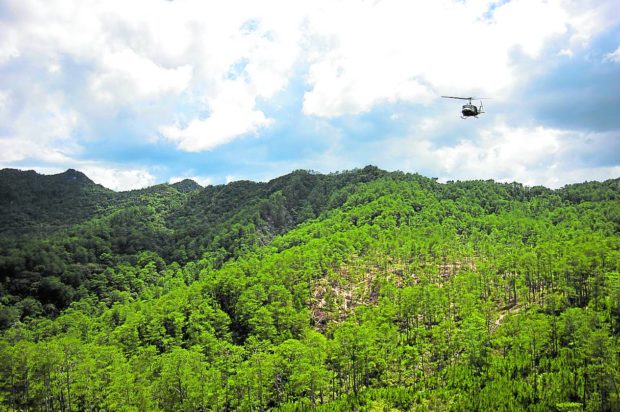
PROTECTION: In this photo taken in 2016, government personnel survey a section of this forest in Bauko, Mountain Province, due to activities of illegal loggers. Agreements between environment officials and dwellers who practice traditional forest protection measures have helped keep most of these trees standing. (Photo by RICHARD BALONGLONG)
BAGUIO CITY, Benguet, Philippines — The Cordillera mountains host 616 million trees nestled in “open” and “closed” forests, as well as tree plantations managed by the government and forest dwellers, officials of the Department of Environment and Natural Resources (DENR) said on Tuesday.
The tree audit was an offshoot of Environment Secretary Roy Cimatu’s 2019 order to determine how many trees remain standing in this city, where the initial tally stood at 2.5 million, of which 400,000 were Benguet pine trees, in order to protect them.
As of 2021, the closed forests, or areas with dense and tall tree clusters, in the provinces of Apayao, Benguet, Mountain Province, Ifugao, Kalinga, and Abra have 158,790,625 trees, said Maximo Soriano, the DENR assistant director for forestry in the Cordillera, at a press briefing.
Open forests, or a combination of grasslands and woodlands, have 361,418,750 trees, Soriano said.
Combined with highland plantations, including projects of the National Greening Program, a reforestation project in Ifugao, and the recently concluded Integrated Natural Resources and Environmental Management Project along the Chico River Basin, the region’s estimated tree population was 616,421,965 as of 2021.
Under review
Special attention has been given to Apayao, which has kept its natural forests intact, said Ralph Pablo, the DENR Cordillera director.
But the DENR has begun reviewing traditional forest protection measures being practiced by indigenous forest communities after forest rangers recovered 137,000 board feet of illegally cut lumber from the region’s protected areas last year.
A memorandum of understanding is being drafted in Mountain Province that will allow forest communities to harvest the trees they grow, Soriano said. The agreement will help set a cap on the volume of trees to be harvested.
Apayao is also testing a new surveillance system that will allow forest rangers to monitor wider tracts of forest. Patrols have been hampered by the pandemic, but illegal loggers have been arrested at the borders, Pablo said.
Cautious
The DENR continues to be cautious about reopening some of these forests to tourists, partly due to the continuing threat of COVID-19, he said.
According to Pablo, discussions have not been initiated about allowing visitors to climb the biodiversity-rich Mt. Pulag National Park, Luzon’s highest peak, which straddles Benguet, Ifugao and Nueva Vizcaya.
An adventure race has been scheduled there in March, but while the competition was approved by the Protected Area Management Board of Benguet, organizers are still required to secure the permission of communities around Mt. Pulag, he said.
The DENR is also monitoring other protected areas, including Mt. Santo Tomas between Baguio City and the Benguet town of Tuba, which was granted a permanent environmental protection order by the Court of Appeals in 2015. The order restricts all activities on the mountain.
Mt. Santo Tomas became a popular trekking site and had drawn tourists because a soap opera was shot on location there. Trekkers also reported an illegal road being carved out of the mountain, which damaged local water sources.
—VINCENT CABREZA
RELATED STORY
Cordillera as nature’s medicine cabinet